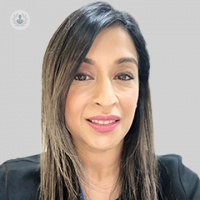Mohs surgery: an in-depth guide
Autore:When it comes to treating certain types of skin cancer, Mohs micrographic surgery is a technique often recommended by surgeons and dermatologists as the “gold standard” and the most highly effective and precise treatment option.
The types of skin cancers that it is effective for include Basal Cell Carcinoma (BCC or rodent ulcers), Squamous Cell Carcinoma (SCC) most commonly. It can also be effective for other rarer tumour types.
Renowned Consultant Plastic Surgeon Miss Rakhee Nayar, who specialises in the surgery, discusses why it's recommended, what to expect during the procedure and potential complications.

What is Mohs surgery?
Mohs surgery, also known as Mohs micrographic surgery, is a specialised surgical technique used to remove skin cancers, particularly those in sensitive areas, such as the face, ears, and for preservation in functional areas such as the hands. It is is named after Dr F Mohs who pioneered the technique in the 1940s.
It can be an excellent technique where certain skin cancers have recurred, have unclear or indistinct borders and where there is a chance that standard surgery therefore may not clear the disease successfully. It is also useful in those patients who have had standard surgery which has previously incompletely removed all the tumour cells. An additional application is in tumour recurrence where patients have previously had treatment with radiotherapy
It is primarily employed for two types of skin cancer: basal cell carcinoma and squamous cell carcinoma. Other rarer tumour types which can be treated with Mohs include Sebaceous carcinoma, Microcystic Adnexal Carcinoma (MAC), Dermatofibrosarcoma Protuberans (DFSP).
Why is Mohs surgery recommended for skin cancer?
Mohs surgery is recommended for several reasons. Firstly, it offers the highest cure rate compared to other treatment methods, making it particularly suitable for skin cancers in cosmetically or functionally critical areas. Secondly, it minimises damage to healthy tissue, and due to less ‘uninvolved’ healthy skin being removed than by standard surgery can often lead to smaller scars and a better aesthetic outcome especially for example where as a consequence of less healthy tissue being removed, a less complex reconstruction can be offered to the patient.
It can effectively treat recurring or aggressive skin cancers that may have failed to respond to other treatments. There are numerous studies showing that skin cancers such as basal cell carcinomas have less chance of recurring after Mohs surgery than when standard surgery is used.
What can I expect during the Mohs surgery procedure?
Mohs surgery is typically performed under local anaesthetic (with the patient awake). The vast majority of Mohs surgery is “daycase surgery” and as it is local and not general anaesthetic patients can eat and drink throughout the day.
Once the skin has been anaesthetised with a needle, the Mohs surgeon will remove the skin growth and place a sterile dressing onto the wound. The patient then goes back to the patient area to await the results.
The skin is then taken into the laboratory where it is placed on slides after being stained and looked at under a microscope. This is usually done by the surgeon and an accompanying consultant pathologist. The slides are checked to see if all of the skin cancer has been removed. If there are any incompletely removed areas, the patient will then return to theatre to have more of the tissue removed from any of the areas of remaining cancer. If this is the case the patient will require a second Mohs stage. The skin sample is again prepared and placed on slides after more local anaesthetic is injected and the process is repeated until all the slides show that the cancer has been removed. The typical waiting time for results is around one to two hours per Mohs stage.
The closure of the wound depends on how large the defect that has been created is. Occasionally small areas can be left to heal on their own and this is called “healing by secondary intent”. Closing with primary closure means direct stitching. Other forms of reconstruction if the defect is wider or deeper and requires more than just stitches can be with skin grafts or a local flap. In the hands of a plastic surgeon this will usually all be performed on the same day as your Mohs surgery. Different units offer different levels of service and sometimes the reconstruction element may be delayed.
Very occasionally, if a more complex reconstruction is required to close your wound you may require a general anaesthetic and will be asked to return to the operating theatre on a different day.
What are the risks and discomforts of Mohs surgery?
Risk of Mohd surgery include but are not exclusive of:
- unfavourable scarring including hypertrophic and keloid scars.
- infection.
- bleeding.
- recurrence.
- pain.
- nerve damage leading to numbness or weakness to affected areas.
- graft or flap failure.
- wound dehiscence.
- delayed healing.
- adverse cosmetic appearances following surgery including contour defects and asymmetry.
There is also a small risk that resection may not be feasible on the day of surgery requiring later further surgery or possible radiotherapy.
In some cases, there may be also specific risks relating to where the skin lesion is on your body. This should be explained in detail by your surgeon in your pre operative appointments.
How long will the operation take?
Due to the complex nature of the surgery and the slide preparation most surgery can take up to five or more hours to complete. The waiting time for results per Mohs stage can be up to two hours. As you will often have some periods of waiting for results in between Mohs stages, you may wish to bring something to help pass the time such as an electronic tablet or a book.
If you would like to book a consultation with Miss Nayar, do not hesitate to do so by visiting her Top Doctors profile today.


